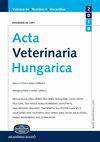小反刍动物慢病毒流行病学血清调查:流行率、年龄和品种影响
IF 0.8
4区 农林科学
Q3 VETERINARY SCIENCES
引用次数: 0
摘要
摘要本研究通过2018年土耳其西部爱琴海地区绵羊和山羊群体中小反刍动物慢病毒(maedii - visna病毒)和山羊关节炎脑炎病毒感染的流行病学血清监测调查。从该地区的92个村庄共收集了1840份血清样本(595只山羊和1245只绵羊),并通过间接ELISA进行了检测。39份山羊血清和304份绵羊血清小反刍动物慢病毒抗体阳性。绵羊和山羊患病率分别为24.42%和6.55%。在爱琴海地区的小反刍动物中平均发现18.64%。小反刍动物慢病毒在Pirlak和Pirlak杂交绵羊以及Saanen和Saanen杂交山羊中的流行率较高(P <0.05)。发现患病率随着年龄的增长而增加,因为年龄大于48个月的动物比0-24个月或25-48个月的年龄组更高(P <0.05)。此外,小反刍动物慢病毒在绵羊中的流行率高于山羊(P <0.0001)。运用流行病学方法,本研究有望为小反刍动物慢病毒感染的控制和预防做出贡献。本文章由计算机程序翻译,如有差异,请以英文原文为准。
Epizootiological serosurvey on small ruminant lentiviruses: Prevalence, age and breed effects
Abstract In this study, the prevalence of small ruminant lentivirus, i.e. Maedi-Visna and caprine arthritis encephalitis virus infections in sheep and goat populations were investigated through epizootiological serosurveillance in the Aegean region located in western Türkiye in 2018. A total of 1,840 serum samples (595 goats, 1,245 sheep) were collected from 92 villages in the region and examined by indirect ELISA. Thirty-nine goat and 304 sheep sera were found positive for small ruminant lentivirus antibodies. The prevalence was 24.42% in sheep and 6.55% in goats. An average of 18.64% was found in small ruminants in the Aegean region. The prevalence of small ruminant lentiviruses was found to be higher in Pirlak and Pirlak hybrid sheep and in Saanen and Saanen hybrid goats ( P < 0.05). The prevalence was found to increase with age, as it was higher in animals older than 48 months than in the age groups of 0–24 or 25–48 months ( P < 0.05). Moreover, the small ruminant lentivirus prevalence was higher in sheep than in goats ( P < 0.0001). With the epizootiological approach, this study is expected to contribute to the control and prevention of small ruminant lentivirus infections.
求助全文
通过发布文献求助,成功后即可免费获取论文全文。
去求助
来源期刊

Acta veterinaria Hungarica
农林科学-兽医学
CiteScore
1.80
自引率
0.00%
发文量
39
审稿时长
>36 weeks
期刊介绍:
Acta Veterinaria Hungarica publishes original research papers presenting new scientific results of international interest, and to a limited extent also review articles and clinical case reports, on veterinary physiology (physiological chemistry and metabolism), veterinary microbiology (bacteriology, virology, immunology, molecular biology), on the infectious diseases of domestic animals, on veterinary parasitology, pathology, clinical veterinary science and reproduction.
 求助内容:
求助内容: 应助结果提醒方式:
应助结果提醒方式:


